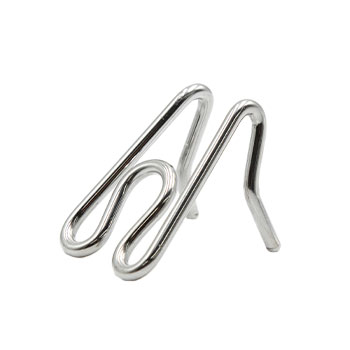Key Features
- Available in Small and Medium
- Stainless Steel links
- Comparable to Herm Sprenger collars
- Dominant Dog Collar available
- Need to lengthen your collar? Get extra links
Product Description
A Message from Ed Frawley on Prong Collars
Additional sizing and product information can be found below after Ed's message.
I call using a prong collar "Power Steering for Dogs." A prong is probably the most misunderstood training tool there is in dog work, next to the whip. So many people take one look at it and say, "Oh! I could never use that on my dog!" Then when I explain how it's used and why, they call back and say "Ed, this is the greatest thing since sliced bread!"
I get asked all the time if a prong collar is appropriate for puppies. The answer is very simple. If properly used, a prong is one of the most humane and effect training tools there are. Can it be abused? Absolutely. Any training tool can be abused. If you want to learn how to train with a prong collar, enroll in my Basic Dog Obedience course.
When a prong collar is used in training, the handler must first realize that a dog who required a level 8 correction before will now, with a prong, probably require a level 2 or level 3 correction. What this means is that a strong dog that had so much drive that it was too much for a small person to handle is now easily controllable without a lot of effort.
If you are a new Schutzhund trainer or a police service dog handler, you are going to need a prong collar.
The first people I usually recommend for the prong collars have 3 to 4 month old pups that pull them down the street when they take them for a walk. These dogs need a prong. There is no correction needed from the handler when a prong is worn during walks. The pup (or dog) gives itself a correction when he hits the end of the leash.
When this happens, the handler is there to soothe the shock with praise if the pup yelps. Within one training session every dog is going to be walking slowly by his handler, there is no longer any pulling. In addition the handler is not the bad guy in this work. How could he be? He is soothing and praising the dog after it yelped from a self-induced correction when it hit the end of the leash?
Older dogs sometimes need a prong collar when normal corrections with a choke collar do not have the intended results (which means they do not effect the dog). My feeling is that any time a dog requires a level 7 correction for normal training, he needs to be worked with a prong collar from that point on.
It's the job of the handler to read their dog. New handlers tend to go out and give the same level of correction with a prong that they did with a choke collar. This is unfair to the dog.
A prong collar is designed to be snug, almost tight, on the dog's neck. Many handlers need to take a link or two out of the collar to get the correct fit. Keep these links. If you have a young dog, you will probably need to use them when the dog grows up. The point is that if a prong collar is too loose on a dog's neck, the collar loses its effectiveness.
Some dogs have very large necks, if you have such a dog you may have to purchase additional links for the collars which can be purchased separately.
With regards,

Ed Frawley, Owner of Leerburg
Learn more about Ed and Leerburg
Our Leerburg Stainless Steel Easy-On Prong Collar makes it easy to put on a prong collar. With just one simple buckle snap, you can take off the prong collar without having to wrangle with links that are difficult to pinch together.
The Leerburg Stainless Steel Easy-On Prong Collar will last you for years. Because of the superior stainless steel used, this prong collar will never rust (although it may tarnish over time). We have two sizes currently available. If you need to accommodate for a larger neck, you can also purchase extra links.
Prong collars are a safer alternative to slip collars and flat collars. When properly placed, a prong collar won't apply pressure to the dog's trachea. Excessive pulling on a flat collar can cause permanent damage to a dog's windpipe. However, with a prong collar, there is a pinching sensation that instantly releases as soon as the dog "yields to the leash" (or stops pulling).
Always Use a Backup Collar
Because of the nature of prong collars, it is imperative to use a backup collar. Prong collars can fall apart at a moment's notice. We implore you to use a prong collar with a Dominant Dog Collar. You'll also need a leash that can attach to both collars. View our Prong Collar Leashes or get an adapter.
Never use a prong collar with a retractable/flexi lead.
Sizing
For more information on sizing, see our article How to Fit a Prong Collar.
| Size | Collar Measurement | Link Thickness | Link Length |
|---|---|---|---|
| Small | Neck Size Up To: 16.25" (including buckle) | 2.0mm | 1 1/4" |
| Medium | Neck Size Up To: 22" (including buckle) | 3.0mm | 1 5/8" |
Have you used this product?
Your review helps others choose the right products for their dogs. Let them know what you think!
Write a Review
















